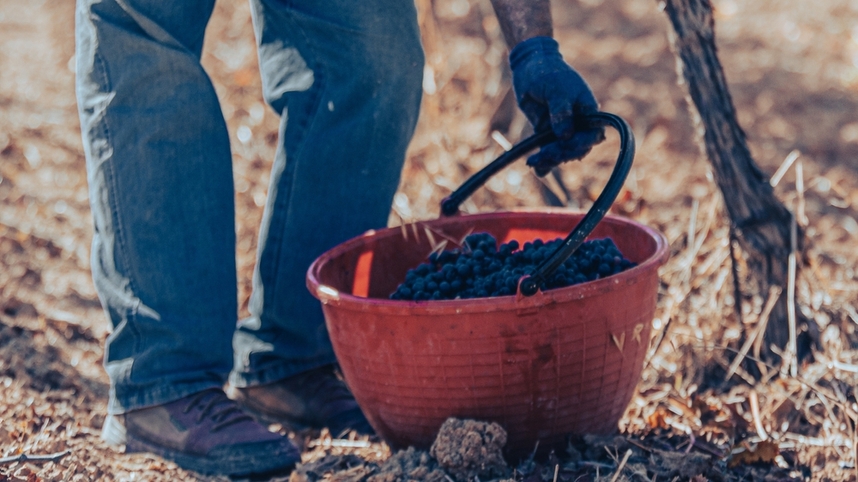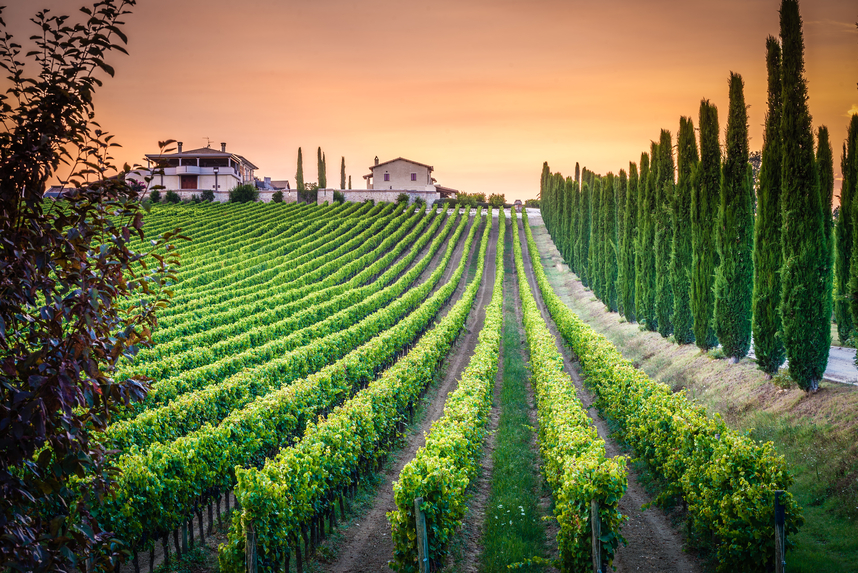Umbria is a small region in central Italy that offers an enchanting variety of landscapes that enchant visitors, but it is also rich in wines and gastronomic products that captivate the senses! Bordering Tuscany and Latium, Umbria boasts an assortment of indigenous and non-indigenous grape varieties, from which white and red wines are produced that are recognised by oenologists and wine enthusiasts the world over.
Here's everything you need to know about the wines of Umbria, from their birth to their pairing on the table!
The Origins and History of Viticulture in Umbria
From an oenological point of view, Umbria has been affected by influences and comparisons over the centuries. On the one hand, it has enjoyed the winemaking techniques brought by the Etruscans, who proved to be the first true masters in this art. On the other, it has suffered the harsh comparison with more developed and well-known oenological realities, such as that of Tuscany. However, this small region in Central Italy found a way during the 20th century to rediscover and enhance the grape varieties of its area with a production of white and red wines appreciated by all wine lovers.
It was 1968 when Umbria obtained its first regional denomination for Torgiano wine; however, this is only one of many crucial stages in the history of wine in Umbria. The Etruscans realised the wine-growing potential of the area and took advantage of the conformation of the Umbrian territory to develop an innovative winemaking system, rooted above all in Velzna, today's Orvieto: tuffaceous quarries located on various levels, used for pressing the grapes, fermenting the must and storing the wine.
With the end of the period of Etruscan domination, the fortunes of the local wine did not decline, which continued with further developments during the Roman Empire and the Renaissance. Phylloxera marked a period of crisis in the 19th century, but the region's advancement in the Italian wine scene - and not only - was not interrupted by the devastating action of this parasite: in the following century there was in fact a rediscovery of Umbria's ancient native vines, which local growers decided to exploit, allowing Umbria to emerge from the shadow of neighbouring Tuscany with the popular and renowned Chianti red wine.
So it was that we arrived in 1968, with the first great achievement of Umbrian oenology, but not the last: the first DOC was followed by the obtaining of other denominations, until the region could count 2 DOCG, 13 DOC and 6 IGT.
Between autochthonous and imported: Umbria's terroirs and main grape varieties

There is something poetic about the concept of terroir, which goes beyond the generic meaning of 'place' or 'territory'. It is in fact the union of the characteristics - climatic, physical and geological - that allow a grape variety to express itself through its wines. Umbria's terroir can vary depending on the area, generally presenting cold and rather rainy winters and hot and dry summers, which guarantee the vines good exposure to the sun.
The Lake Trasimeno area, on the other hand, is milder in terms of temperatures. The backdrop to the rows of vines are rolling hills, woods and small villages of great interest to tourists, while another noteworthy element is the composition of the soil, rich in limestone and clay, especially in the area of the Colli Perugini and Torgiano, with a good presence of tuff and marl in the area around Orvieto.
These characteristics of the Umbrian wine territory create ideal conditions for the cultivation of a wide range of red and white grape varieties (with a prevalence of the latter), including the great regional indigenous varieties, Sagrantino, Grechetto and Trebbiano Spoletino, along with Sangiovese, Canaiolo, Malvasia Bianca Lunga, Ciliegiolo, Montepulciano and Verdicchio.
Denominations and characteristics of Umbrian wines
Umbrian winemaking techniques have changed a great deal since the system of stratified caves devised by the Etruscans, but the skills of today's growers and producers bring with them centuries of tradition. The union of past and present has resulted in the region's most representative red and white wines:
- Montefalco Sagrantino DOCG: the name immediately reveals its origin from the Sagrantino grape variety, an indigenous grape of great importance for regional oenology. Montefalco is certainly among the best red wines of Umbria and is characterised by its dark red colour. Structured and with a stubborn character, it shows all its grit in the intensity of its tannins, which soften with age. It is the nose that is conquered first during tasting, which reveals notes of berries and spices, with hints of chocolate, tobacco, star anise and leather.
- Torgiano Rosso Riserva DOCG: the basis of this wine are the Sangiovese grapes, used together with Canaiolo and Trebbiano. However, it is not only the characteristics of the latter that give the product its intense and surprising organoleptic traits. On the nose, it releases aromas of red fruits and spices - including cinnamon and liquorice - while the taste is structured, warm and with slight mineral notes, traits that are accentuated thanks to the minimum ageing period of 3 years.
- Trebbiano Spoletino DOC: this indigenous grape variety gives birth to a fresh and lively product, one of the best white wines of Umbria, which tickles the palate of those who taste it with a noteworthy savouriness and minerality. On the nose, it releases a persistent bouquet of flowers, peach and apricot, with light citrus scents depending on the period of ageing (a minimum of 6 months). Its colour is also remarkable, a straw yellow mottled with green.
- Grechetto DOC: Umbria's indigenous grape varieties include Grechetto, the cultivation and vinification of which gives rise to the white wine of the same name. It is difficult not to be enchanted by its straw-yellow colour with slightly greenish reflections, by the freshness and sapidity of this wine, which releases aromas of white and tropical fruit, such as pineapple, lychee, apple and pear. Citrus suggestions and a hint of minerality on the finish make the taste even more lively.
- Orvieto DOC: a wine of ancient origins and great value, this white wine shows off a straw-yellow colour in the glass, characterised by golden reflections that catch the eye. The organoleptic profile is no less fascinating: the scents of musk and flowers give way, during tasting, to a softness with a slightly bitter finish.
Central Italy in the glass: food and wine pairings from Umbria
Meat or fish recipes? Delicious fried dishes, pasta dishes or risottos? The choice may be hard when trying to put together a well-thought-out menu, but the good news is that bringing Umbrian wines to the table means having a wide range of available pairings. All thanks to the variety of these products!
A glass of Montefalco Sagrantino DOCG, for example, is almost obligatory for those who - fascinated by the gastronomy of this Italian region - want to taste its most famous and delicious meat dishes. Thanks to its intense aromas and rather pronounced tannic profile, it can be paired first and foremost with platters of sliced meats and cold cuts, among which ciauscolo, prosciutto di Norcia, Coppa and corallina, a coarsely minced savoury salami, stand out. It is also excellent with main courses, from braised and roasted meats to stews and game (try it with wild boar sausages, for example), but also goes well with hearty legume soups.
And what about recipes with more delicate flavours? The Torgiano Rosso Riserva - with its floral and fruity profile - plays an excellent role as an accompaniment to pasta and white meat dishes, but also surprises positively when paired with truffle-based preparations, another great product of this area.
Better known for its meat dishes, Umbria does not, however, fail to offer diners a good variety of recipes based on trout and carp, as well as cod, to which the regional wine tradition flanks its great whites. In addition to being an excellent aperitif, along with cheeses and appetisers, a glass of Grechetto Montefalco DOC is just what is needed if the menu includes shellfish dishes, to which it is well suited thanks to its fresh and tropical aromas.
On the other hand, a bottle of Trebbiano Spoletino can be uncorked when fish is the protagonist of the entire menu, from hors d'oeuvres and tasty sauces to carpaccio and baked or stewed dishes.
Finally, Umbria has another excellent ace up its sleeve: its desserts. For those looking for sweetness and lovability even in the glass, the ideal candidate to accompany desserts is Orvieto Classico Superiore DOC late harvest, which owes its extraordinary aromaticity to the growers' decision to harvest the grapes late, so as to increase the concentration of sugar in the berries.
With its heady perfume of dried fruit and honey, and full-bodied flavour, slightly acidulous on the finish, this wine is a worthy accompaniment to Terni's pampepato, torciglio, cicerchiata, tozzetti, rocciata di Assisi and pinoccate, and many other delicious local desserts.
The Umbria of wines has no more secrets for you. All you have to do is find the bottle that most appeals to you in the Svinando catalogue!

